
Recent bakes
There were no loaves in my previous blog post, so I guess it's time to make things right again.
I still have some dried fruit and different nuts lying over from various Christmas projects, and with my chronic sweet tooth, I just couldn't resist putting them to good use as soon as possible. I mixed two batches of Hamelman's "Whole-wheat Bread with Hazelnuts and Currants" (p. 124). In the first batch, I replaced the currants with chopped prunes and shaped four mini batards. For the second batch, I used walnuts and chopped dates instead of hazelnuts and currants, and shaped regular batards. Some of the mini batards and a crumb shot of the walnut-date bread is shown below:
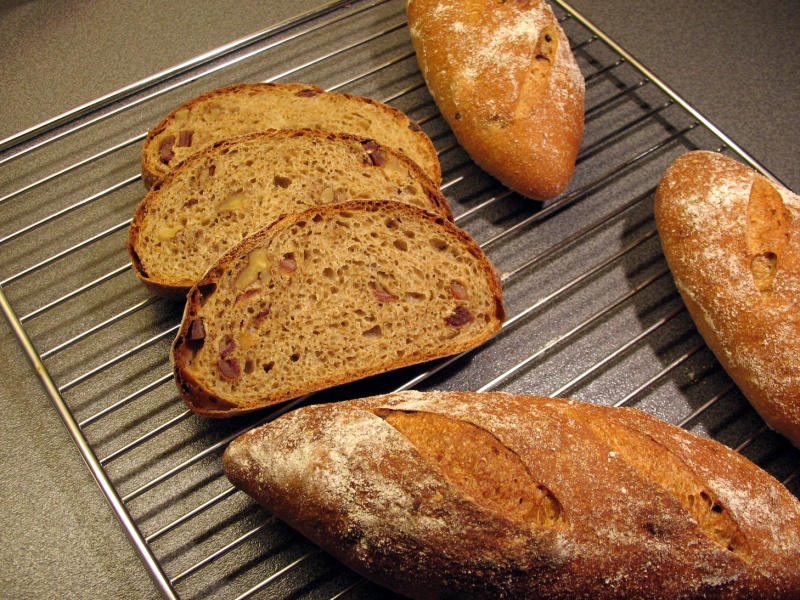
An instant classic in my book, especially the walnut-date combination. The dough has a relatively high hydration (73%), so the crumb is open and light. It's made slightly buttery by the walnuts and the dates add a rather sophisticated sweetness to the bread. It's also pretty good when toasted (trust me).
I've also been baking my everyday pain au levain:
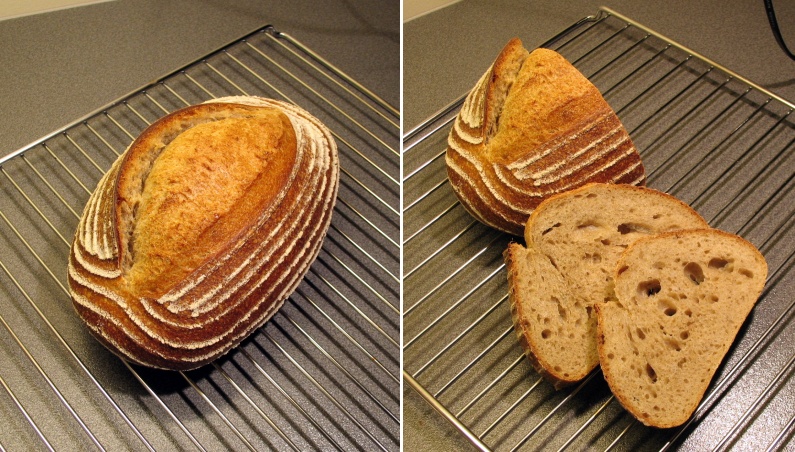
A couple of days ago I came across a book called "Technologie der Backwarenherstellung" by Claus Schünemann and Günter Treu. I don't recall how I got there, it was probably the result of some oddball Google search, but I eventually ended up at Google Books, which has a limited preview of this German title. It appears to be a textbook for the budding German baker, and I found some interesting bits regarding Detmolder sourdoughs. My German is getting increasingly rusty, but I managed to extract some information from the preview at Google Books. I was particularly looking for information regarding the simple Detmolder one-step build, and found a table that will come in handy. The book gives a table with recommended amount of prefermented flour, based on the overall flour combination of the dough. That is listed in the left table below. The column "Rye sourdough" gives the amount of total flour that should be prefermented for the specified rye:wheat combination. The "Prefermented rye" column gives the corresponding amount of rye flour that is put into the sourdough. The book also gives figures for what level of inoculation should be used in a Detmolder one-step build as a function of the average temperature of the sourdough during ripening. That is listed in the right table below.
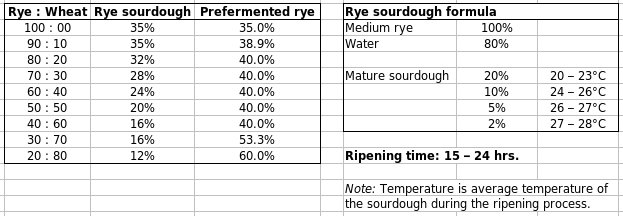
I decided to try out these numbers, and baked my favourite rye (click here for David's complete write-up) based on the above two tables. This loaf is a 70% rye, so I prefermented 28% of the total flour (before: 35%), and inoculated the sourdough with 15% of my ripe, white starter (it's bitingly cold here these days...*brr*... and neither me nor my starter like it).
The bread turned out really good I think! The crumb is not quite as open as before, but the loaf profile is comparatively taller. No distinct differences with regards to taste. The one thing I did notice, was that the mixed dough was a lot less sticky than what I'm used to. Not very surprising probably, since the total amount of prefermented flour is reduced. This is my "other everyday" bread, so there'll be plenty of time to experiment with temperatures, proofing times and formula variables to optimise the loaf.
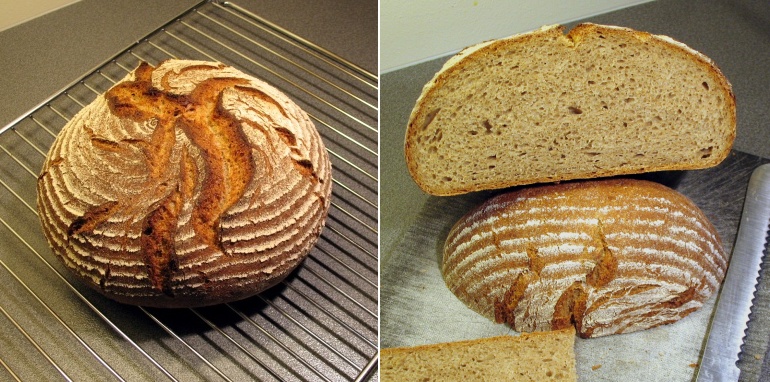
Finally, for dessert, a chocolate cake with luscious hazelnut cream (that was the rest of my hazelnuts...):
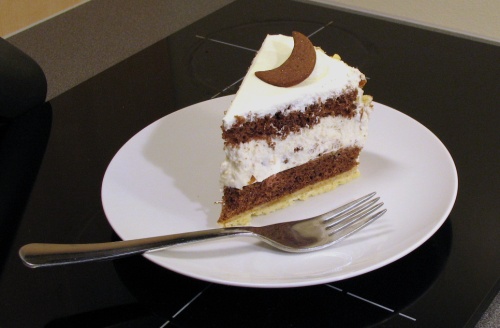


Comments
I can see you have a sweet tooth...me too, the cake is making me drool! The breads look really tasty! Hammelman's bread is of my favorites. I made it last week with apricots and walnuts...Tangy but nice(I had some apricots left over in the pantry). The Detmolder sourdough build always seemed scary to me..this one looks relatively easy and it looks delicious...
Nice bake!
judd
Oh my! Your loaves are always so gorgeous! Are you proofing your pain au levain in an oval brotform? How large? They are beautiful.
Thanks,
Nick
and that walnut-date bread looks fantastic. -dw
All of them look and I am certain, taste amazing!
Eli
Bread and dessert.
Exquisite!
Thanks for your kind compliments all!
@CarlSF: That is strange... I've seen the English version available at chipsbooks.com, but the $100 price tag has always turned me off. I was quite excited to find a rather comprehensive preview of the German version at Google Books. The table is listed on p. 140 of the German version: "Tabelle Nr. 35 - Wertetabelle für die Detmolder Einstufenführung".
@Nathan: Thanks, Nathan :) Pretty much the only English written resource for Detmolder rye sourdoughs that I've seen, is "Bread". If you compare Hamelman's formulas with the guidelines given by Schünemann and Treu, it seems that Hamelman generally preferments more flour than the above guidelines. In Hamelman's caraway rye, a 40% rye, all of the rye flour is prefermented, while Schünemann and Treu suggests that only 40% of the rye flour should be prefermented (that is, merely 16% of the overall flour in the formula). Hamelman also has a 66% rye, which is pretty similar to my rye above, where he preferments 40% of the overall flour, compared to the suggested 28% for a 70% rye above. That's certainly not to say one's right and the other's wrong, however! Prefermenting a large amount of the overall flour will certainly speed up fermentation and result in a sourer bread, but it comes at the expense of dough handling (stickier doughs) and often tighter crumbs. It all comes down to taste and preference, right? Best of luck on those rye breads, and keep us posted on your progress :)
@Nick: Thanks, Nick! Yes, they're proofed in oval brotforms that are designed for approx. 750gr of dough. At the top, they are roughly 25cm long and max. 13cm wide.
Wunderbar, Hans, especially your rye bread! You have managed to get great spring there, for a rye. Actually, ALL your pics are magnificent. Oh, and THAT DESSERT - exquisite torture, sitting here ogling at that!
Hi, hansjoakim.
It took me a while to understand the table, but I think I've got it now. Your observations comparing this table with Hamelman's formulas are interesting.
Did you find that the lower percentage of rye sour resulted in a much longer fermentation time? How about proofing time?
David
Hi David,
And thanks so much :)
I don't think I explained the table very well... just to make sure: What I labelled "Rye sourdough" in the table is the same quantity as Hamelman's "Prefermented flour". That is, the percentage of the total flour that is prefermented. In German rye breads, only the rye is prefermented. The column "Prefermented rye" indicates the percentage of the total rye flour that is taken from the sourdough.
For this bake, I followed the outline given in your post (i.e. 1hr bulk followed by 2hr proof). You might notice that this bread has an increased oven spring compared to our previous loaves. It could be that the 1hr + 2hr schedule is better suited for this amount of prefermented flour, and that our previous loaves proofed a little longer than strictly necessary. This was my first attempt using the Schünemann and Treu outline, so more experimenting is probably necessary.
It's also interesting to note the difference between Schünemann/Treu and Hamelman when it comes to sourdough inoculation: Hamelman suggests 5% and relatively low DDT (approx. 70F if I'm not mistaken, about 21dC). Following Schünemann/Treu, a sourdough kept at this temperature should be inoculated with 20% ripe starter. It's also mentioned in the section about Detmolder one-step builds, that the sourdough temperature should ideally be kept above 24dC at any time during ripening.
I'm not sure how much these minor technicalities might improve bakes for us humble home bakers, but it could still be useful, especially when you're designing own formulas.
Hans,
What lovely breads. And that dessert looks delish. How come you're so good at what you do? How long have you been making bread and desserts?
How those white lines appear on your sourdough breads is something I have yet to learn. I imagine they're from your bannetones?
Thanks for sharing that table!
Hi,
And thanks for your nice words, ques2008! It's always a pleasure to hear from you, and I hope you're having a good start at the new year.
Yes, those lines on the breads are from floured brotforms; really just one of these things, that you sift flour into and then place the dough into for its final proof. You dust the brotform with flour before putting the dough in there, so the dough won't stick to the form, but release easily when you're ready for baking. Remember to place the dough with seam side up, so when you invert the form to release the loaf, you get it right side up, all perky and ready for the oven.
I haven't been baking for very long; according to my Amazon account, I got my copy of Hamelman two years ago this March. Most of the breads you'll buy in shops around here are terrible - industrially produced loaves that are whiter than tooth paste and devoid of nutrition and flavour. I guess I reached my limit, and wanted to learn how to make good bread on my own. Hamelman was my first bread book (silly me), so the learning curve was pretty steep to tell you the truth ;-) Around the same time I also discovered this site and some truly helpful blogs (like SteveB's blog and Susan's wildyeast blog), which all helped tremendously!
and with the tables, more than ever! Thank You! More than you know... I have to digest this first. The lift on your rye is amazing!
Controlling the stickiness... control the speed of fermentation... yeast on steroids... added yeast... stickiness is an indicator... of too much too soon... slow down... the steroids... will get back to you on this later....
Did you ever run across rye recipes where the salt was added early on?
Mini
Hi Mini,
And thanks so much :)
I'm also still pretty much digesting this stuff and playing around with different numbers. I've seen examples where salt is added to the rye sourdough, if that's what you're thinking of? I think one example is the Monheimer procedure, where salt equivalent of up to 2% of the prefermented flour weight is added to the rye sourdough. I'm not really sure what the specific advantages are, apart from having the option of using longer ripening times (up to 24 hours) and a longer "peak period".
Have you tried this?
I know what forgetting the salt can do... talk about speed! I tried to slow down my dough using half the amount of starter and ended up speeding it up. So it acted just like I had added twice as much starter to the dough (or the original amount.) I'm throwing in the salt from the beginning of the main dough mix from now on. No way to forget it then. It is also helpful with warm scalded flour.
As you know I don't add yeast to my rye sourdough normally, I have much longer rising times.
Is it possible that the Detmold process was developed to incorporate instant yeast into the then longer sourdough process? To shorten proofing times and give the baker more shop space without taking too much flavor from the longer process?
Mini
You mean that perhaps the one-step process was developed so instant yeast could shorten proofing times? That's definitely a possibility. That way, you would obtain many of the benefits of a rye sourdough (aroma, flavour, shelf life, improved crumb structure) and at the same time have a predictable proofing schedule for each dough due to baker's yeast.
Another advantage, as I see it, is that the one-step sourdough remains ripe far longer than the classic three-step version. As indicated in the table above, a one-step sourdough can be used 15 - 24 hours after mixing, whereas a three-step will become overripe and loose vigour much quicker. In a bakery, with a one-step sourdough, you could mix up a huge pile of sourdough a day in advance, and then use this as needed on day 2, when many different final doughs are mixed.
thanks for your reply. "whiter than toothpaste" - i chuckled when i read that.
your first ref was hamelman, mine was BBA (Reinhart). with all the good things i hear about hamelman, i think i'll boogey over to the library to see if they've got a copy.
again, your breads are always lovely. makes you want to hang them on the kitchen wall instead of devour them.
keep it up. your blogs are sheer delight.
Whiter than toothpaste - you wouldn't think it could be possible, but I swear those dreadful sandwich breads people are buying... it should be called "colgate sensation whitening" or something similar.
You can take a sneak peek inside "Bread" if you head over the publisher: Click here for that. If you look to the right, you'll find a link that says "Read Excerpt". Clicking that will give you a .pdf copy of the entire chapter devoted to breads made with a yeasted preferment. I also believe Amazon.com will allow you to search and browse large parts of the book if your library is out of copies.
Again, thanks for your encouraging words and kind compliments!
thanks for the tip, Hans. i also saw some of those lovely brotforms on breadtopia.
Hi Hansjoakim
Beautiful loaves as always. Love everything you bake. I agree whole-heartedly with David's assessment about your "refined aesthetic sensibilities" when he made your favorite 70% sourdough rye. Your desserts, as well as all your breads, show your perfectionist bent and are truly professionally done. I have not known of anyone who has a sweet tooth like you and is able to feed that sweet tooth with such delicate creations.
You mentioned Detmolder one-step build, are you referring to shortening the usual three stages of rye sour build into one?
Next is regarding fermentation time. I notice in all of Hamelman's rye bread formulas, none has total fermentation time (bulk + proofing) more than 2 hours. The higher the percentage of rye flour, the shorter the total time for fermentation. For instance, Detmolder three-stage 90% Sourdough Rye has one hour bulk + 20 minutes proofing, and Light Rye Bread (15% rye) has one hour bulk + 50-60 minutes proofing. I understand the rationale behind such short total fermentation time, but have not been able to obtain satisfactory results using Hamelman's formula, even with the addition of commercial yeast. My Thiézac's pure sourdough rye (100% rye) had 2 hours bulk + one hour proofing, and that worked very well for me. I read your 70% sourdough rye formula as in David's post and found that your total fermentation time was also 3 hours in total! My question is: Have you experimented with other fermentation durations and found 3 hours work the best? Have you done sourdough rye with less (or more) fermentation time and how did you like it?
Thank you.
Shiao-Ping
Hi Shiao-Ping,
And thank you so much for your very kind compliments! Such feedback is truly heartwarming, especially when it comes from such a fearless, inspirational and creative baker as yourself! We all appreciate the enthusiasm you share with us here at TFL.
You're right about the Detmolder one-step build: That's simply mixing the whole sourdough at once. The classic method is the three-step build, but the high work load associated with it and the required careful monitoring of ambient temperatures have lead most German bakeries to use the much simpler one-step build. There are also many other ways to elaborate rye sourdoughs: There's a Detmolder two-step build (surprise, surprise!) and various "short sours" (mixed with high hydration levels at high temperatures) and salted sourdough builds. I believe the one-step build is becoming more and more common. Compared to the full three-step, the one-step is more acidic and tangy and has less leavening capacity. That's why it's common to supplement the formula with fresh yeast when a one-step build is used.
I believe Hamelman's rationale of operating with short fermentation times, is that he preferments a huge chunk of the overall flour. Actually quite a bit more than what's standard in many German bread formulas (i.e. Hamelman preferments 40% of the flour for his caraway rye, while a typical 40% sourdough rye usually has 15 - 20% prefermented flour). This provides the required acid levels to get a well-developed crumb (otherwise you risk running into the "starch attack" when you bake the bread, i.e. you get those awful, gaping holes in what should be a relatively uniform crumb with small air pockets), and lots of flavour. A dough with this level of preferment really can't stand up to much fermentation time before the dough structure starts to break down, so Hamelman often adds up to 1.5% of fresh yeast so the breads can be fermented and proofed in reasonable time. I've made most of Hamelman's rye breads, and I've usually found his timings to be very accurate. When you say that you have not obtained satisfactory results, do you think you've under- or overproofed the doughs? The DDT is quite important to monitor, so that could be something to pay attention to at least. Apart from the hydration (which I find to be typically 5-10% too low for my rye flour), I've found his formulas to work quite well, including the mixing times.
It's right that the 70% rye described in David's post has a 1hr + 2hr total fermentation time. But there's no fresh yeast added to the final dough, and the sourdough is a Detmolder one-step sour (with relatively weak leavening capacity). I haven't really tried varying the proofing times too much, as this scheme just "works" for this dough. You could alternatively lower the amount of prefermented flour and increase the total fermentation time, but I'm not sure how much you would gain by that to be honest. There's so much "inherent" flavour in both rye flour and the ripe sourdough, so the "French pain au levain" way of thinking, where we use long fermentation times to coax those delicate flavour notes out of wheat, doesn't really apply here.
I hope some of that made sense! Let me know if you think I can aid in troubleshooting some of those Hamelman formulas, Shiao-Ping.
Hi hansjoakim
Thank you for your detailed explanation. Your points are very clear. Have I under- or overproofed my Detmolder Three-Stage 90% Sourdough Rye dough? I use Thiezac 100% sourdough rye as a reference point. My Detmolder dough appeared to be under-proofed to me (after 20 minutes bulk and 1 hour proofing). I followed Hamelman's instruction as close as I possibly could. The bread came out as dense as a stone. I did observe the fermentation temperatures carefully. What I think was the reason behind my rather under-proofed dough going into the oven was probably that my rye sour was not at its best condition. I did use instant yeast, but still no help.
I have since made the Detmolder recipe again, but with a longer fermentation time (2 hours bulk and 1 hour proofing). I am much happier with the result.
What I find interesting is a comparison between the Thiezac and the Detmolder methods:
(1) Thiezac 100% pure sourdough rye has a rye sour that is built over three days, its prefermented flour is 34% of total flour, and it requires you to do a 2 hour bulk and 1 hour proofing.
(2) Hamelman's Detmolder 90% sourdough rye has a three-stage rye sour built over roughly one and a half day; its prefermented flour is 38% of total flour, and it requires you to do a 20 minutes bulk and 1 hour proofing.
Thank you again for any thoughts you might have. I'll have to read your earlier comment again to internalize it.
Shiao-Ping
Hi Shiao-Ping,
I've just re-read your Thiezac post, and I'm trying to think about my own ripening/fermentation/proofing times.
I think it's safe to say that the Detmolder three-step 90% rye was underproofed. What you're saying seems to indicate that, and I guess a less-than optimal rye sourdough is to blame. As an option in the formula, Hamelman adds a speck of yeast, but the majority of leavening should come from the ripe and active sourdough. Did you notice any increase in volume during the 20mins + 1hr fermentation/proof?
One way to proceed, is to take a closer look at your rye starter and how active it is. Do you store it mainly in the fridge? In order to gauge its activity, try to figure out what inoculation rate you need to build a ripe rye sourdough in e.g. 12 or 14 hours. Just the other week, I made a new rye starter. If I mix: Medium rye flour 100%, Water 100%, Rye starter 6-7% with room temperature DDT (approx. 24dC), this will be tangy and ripe in roughly 12 hours. You could use those figures to gauge the activity of your starter. I'm thinking that if it is behaving a bit sluggish, your sourdough has probably not developed according to the Detmolder formula in that three-step build.
Regarding the Thiezac method, I had not heard of it before you described it in your recent blog, Shiao-Ping. I'm not very familiar with timings and inoculations when the sour is being retarded during the build. To be honest, I'm not sure what kind of positive effect retarding has on building the sourdough like that. Well, we know that colder temperatures favour acetic acid over lactic, but once the sourdough reaches average refrigerator temperatures, I would expect most activity to halt pretty much completely. Considering that the total fermentation time of the Thiezac (after mixing the final dough) is roughly 3 hours, I would also here guess that the retarded rye sourdough is not overtly active. I'm sure it does infuse the loaf with much aroma and flavour, but I'm thinking that much of the leavening is produced by the instant yeast in the formula. If you're up for it, it could be worthwhile to try baking the Thiezac with a Detmolder one-step build instead of the long, three-day build. Preferment the same amount of total flour, but with a single: Medium rye 100%, Water 83%, Rye starter 5% build, that you let ripen 14 - 16 hours. You might have to adjust the amount of rye starter you use to inoculate the mix - you definitely want an airy, delicate-looking, tangy-smelling sour before you mix the final dough. As for fermentation/proofing times, you could either go with Thiezac's original schedule, or try my 1hr + 2hr scheme. Keep in mind that the instant yeast in Thiezac's formula might speed up the fermentation compared to my 70% rye where there's no yeast added. It's also worthwhile to remember that fermentation/proofing times typically go down as the amount of rye goes up.
Hi hansjoakim
Thank you for your valuable information on the rye starter as well as the Detmolder one-step rye sour build. After I read your comment above, I went and read all of Hamelman's rye sourdough formulas, comparing percentages and formulas. I am finally getting somewhere. Thank you so much for clarifying those points for me.
Many thanks again.
Shiao-Ping
Hans, the apparent ease with which you create these brilliant breads and desserts, is Mozzart like. Lovely , lovely. To see that far into the details, with such ease, blows me away. Ray
I could bake bread like that! They are beautiful loaves. I'll hopefully be able to bake some like that myself.